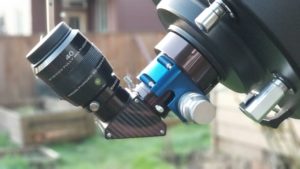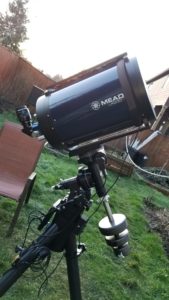40mm Explore Scientific 68° Review
By: Vlad Fedosov
Intro:
My quest to acquire the 40mm Explore Scientific(ES) 68° eyepiece began on a wonderful dark starry 2017 night. I was at one of my astronomy clubs summer star parties cruising some very large nebula and star clusters with my William Optics GT102 APO. Having ironed out my eyepiece set to just 3 general-purpose eyepieces(this does not include my binoviewer eyepieces and planetary orthos) consisting of the: ES 25mm 100°, ES 14mm 100°, and 5.5mm 100° I thought I had all that I needed. But during that wonderful summer night as I was observing objects such as the North American nebula, and California nebula I came to realize that while the view through the 25mm 100° was spectacular it was very hard to take in at the same time and seemed too magnified. I got a hunch that a lower power eyepiece would provide a better view especially while using light pollution filters.
Not knowing if I wanted to splurge $310 for a brand new ES 40mm I kept an eye open on Cloudy Nights(CN) for a used unit, and one point even posted a wanted ad. No luck for me. I did happen to come by a GSO 42mm Super View eyepiece as a temporary fix and as an eyepiece to put my hunch to the test. On a cold winter night, under a truly dark sky by Moro, OR(see observing report) I got a chance to compare the view of the Horsehead nebula with my ES 25mm 100° and the 42mm 65° GSO Super View in my 16” Meade Lightbridge. While yes I know that the exit pupil with the 42mm is larger than 7mm both me and an observing buddy agreed that the nebula was easier to see in the 42mm eyepiece(used an H-Beta filter with both eyepieces). Now I knew that I had to have the ES 40mm!
Much to my delight, I stumbled on a few threads on Cloudy Nights about some refurbished ES eyepieces that were available on eBay. There it was; the 40mm ES at a great price! I must say that I was a bit hesitant about a refurbished eyepiece that is this complex in design. I’m fairly picky about my optics and while I don’t mind a bit of cosmetic wear, the optical train must be mint.
These refurbished units were apparently offered by the Telescope Wearhouse and people on CN said that the owner Bill is a great guy. I decided to send him a message on eBay asking what the story was behind these eyepieces. My main question was whether these were just customer returns, or if they were truly defective units that have been taken apart and fixed. Bill was prompt to reply and confirmed that he bought these directly from ES and that these where just customer returns and was NOT taken apart. He also mentioned that the units he had listed on eBay(at the time I was talking to him) where truly like new and that he had some with some cosmetic scuffs that he would sell later. Not minding a little cosmetic wear(since this is an eyepiece I would also like to use for outreach) I asked Bill about one of those units. He was prompt to send me pictures of the actual unit in question and while it did have some scuffs he said that the glass was mint. What can I say, the price was VERY right and I jumped on the deal!
The unit arrived in about 3 days after order, and I was delighted to see that the glass looked absolutely brand new! The body defiantly had some nicks and scuffs on it, but for this particular unit, I was ok with it. Please keep in mind that the unit that I got was not necessarily an example of what all of these refurbished units will look like. I knew that mine would have these cosmetic defects and the price I paid did reflect this. After snapping a picture to share with you guys of how the eyepiece looked on arrival I proceeded to use a permanent sharpie to black out all the nicks. The eyepiece looked much better!

Testing:
The better news? It was actually going to be a clear night! I eagerly setup my big gun, the 12” Meade LX-200 R(ACF). The 40mm ES produces 76x and .89° in the big SCT. Even before it was completely dark I could not help but point the scope at m42. What a view! The FOV seemed huge to me(keep in mind that I’m used to a 100° FOV). The stars were tack sharp across the entire FOV. Looking at m42’s trapezium I saw 4 little gems. Wait I said, there is the G star! Excited I wanted to see if I could spot the bit tougher F star. With a bit of scrutiny, it was there for the taking. Amazing to see both of these at only 76x! So far the 40mm was doing better than expected.
It was interesting to me how the 42mm GSO would compare to the much more expensive 40mm ES. I started out by comparing the overall FOV. I immediately noticed that the overall FOV of the ES 40mm was much larger in appearance than the 42mm GSO. Switching from one eyepiece to the other I noted that the FOV in the 40mm ES is about 15-20% larger even though the calculated FOV was supposed to be very slightly smaller in the ES 40mm. The advertised FOV of the 42mm GSO is 65° but from my estimates, it is closer to 55°. The other difference noted in the overall FOV is that the 40mm ES had a very defined field stop whereas the 42mm GSO had a very soft fade into the field stop.
The views on-axit where very similar in transmission and detail in both the eyepieces. This was true for about the first 25% of the FOV. After that, the 42mm GSO defiantly started to display some flaring in the stars and the outer 30% was not that great looking. The 40mm ES displayed nice and sharp stars almost to the edge of the FOV. Eye placement was also less critical with the ES 40mm and it was just easy to take in the entire FOV. The GSO 42mm was not too bad in this regard ether though. I must say that the ES 40mm was definitely quite the improvement in performance. Well worth it to me. Besides performance the other reason that I wanted to upgrade to the ES 40mm was weight. Since all my other eyepieces are heavy units it made sense to have a heavier 40mm so that the balance of my scopes remains the same. This can be the opposite case for you if you use other eyepieces that are lighter.

For those curious as how the 68° 40mm compares to the 100° 25mm… The 25mm ES 100° is by far my most used eyepiece and I do not think that the 40mm will replace it. The 25mm just frames most DSO very well in all of my scopes and provides a good balance between magnification and contrast. For larger more extended objects the 40mm is going to be better as the FOV is just easier to take all in at once.
As mentioned above this is defiantly going to be my eyepiece of choice for outreach. The hairs on the back of my neck stand up when someone goes to grab my $800 ES 25mm as they attempt to take a look through my scope. A 100* FOV eyepiece is also not ideal for someone that is not used to using one as you really have to be right up to the eyepiece to appreciate the entire FOV. I’m also a person that does not want to stick in a cheap plossl into the focuser for someone wanting to take a look, especially after they see me taking out the 25mm monster that was in there before.
Conclusion:
I will conclude by saying that the Explore Scientific 40mm 68* is a great eyepiece. It is a pleasure to use and defiantly up to the standard of all the other great Explore Scientific eyepiece that I have had the pleasure to use(which is most of them). As far as the aspect of buying a refurbished eyepiece, I can comfortably say that I would not hesitate to save some money and purchase one. Bill from the Telescope Warehouse was awesome to deal with, and I’m sure would take care of any issue if you happened to have one.
Support AVT-ASTRO
If you found this review helpful and are considering purchasing the product that was discusses please consider purchasing this item on Agena Astro using the link here. I get a small commission from Agena Astro and it really helps to pay for running this site!
